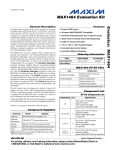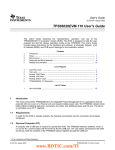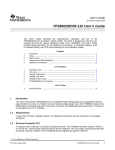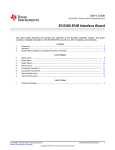Download Texas Instruments TPS2151 User's Manual
Transcript
User’s Guide March 2002 PMP Portable Power SLVU067 IMPORTANT NOTICE Texas Instruments Incorporated and its subsidiaries (TI) reserve the right to make corrections, modifications, enhancements, improvements, and other changes to its products and services at any time and to discontinue any product or service without notice. Customers should obtain the latest relevant information before placing orders and should verify that such information is current and complete. All products are sold subject to TI’s terms and conditions of sale supplied at the time of order acknowledgment. TI warrants performance of its hardware products to the specifications applicable at the time of sale in accordance with TI’s standard warranty. Testing and other quality control techniques are used to the extent TI deems necessary to support this warranty. Except where mandated by government requirements, testing of all parameters of each product is not necessarily performed. TI assumes no liability for applications assistance or customer product design. Customers are responsible for their products and applications using TI components. To minimize the risks associated with customer products and applications, customers should provide adequate design and operating safeguards. TI does not warrant or represent that any license, either express or implied, is granted under any TI patent right, copyright, mask work right, or other TI intellectual property right relating to any combination, machine, or process in which TI products or services are used. Information published by TI regarding third–party products or services does not constitute a license from TI to use such products or services or a warranty or endorsement thereof. Use of such information may require a license from a third party under the patents or other intellectual property of the third party, or a license from TI under the patents or other intellectual property of TI. Reproduction of information in TI data books or data sheets is permissible only if reproduction is without alteration and is accompanied by all associated warranties, conditions, limitations, and notices. Reproduction of this information with alteration is an unfair and deceptive business practice. TI is not responsible or liable for such altered documentation. Resale of TI products or services with statements different from or beyond the parameters stated by TI for that product or service voids all express and any implied warranties for the associated TI product or service and is an unfair and deceptive business practice. TI is not responsible or liable for any such statements. Mailing Address: Texas Instruments Post Office Box 655303 Dallas, Texas 75265 Copyright 2002, Texas Instruments Incorporated EVM IMPORTANT NOTICE Texas Instruments (TI) provides the enclosed product(s) under the following conditions: This evaluation kit being sold by TI is intended for use for ENGINEERING DEVELOPMENT OR EVALUATION PURPOSES ONLY and is not considered by TI to be fit for commercial use. As such, the goods being provided may not be complete in terms of required design-, marketing-, and/or manufacturing-related protective considerations, including product safety measures typically found in the end product incorporating the goods. As a prototype, this product does not fall within the scope of the European Union directive on electromagnetic compatibility and therefore may not meet the technical requirements of the directive. Should this evaluation kit not meet the specifications indicated in the EVM User’s Guide, the kit may be returned within 30 days from the date of delivery for a full refund. THE FOREGOING WARRANTY IS THE EXCLUSIVE WARRANTY MADE BY SELLER TO BUYER AND IS IN LIEU OF ALL OTHER WARRANTIES, EXPRESSED, IMPLIED, OR STATUTORY, INCLUDING ANY WARRANTY OF MERCHANTABILITY OR FITNESS FOR ANY PARTICULAR PURPOSE. The user assumes all responsibility and liability for proper and safe handling of the goods. Further, the user indemnifies TI from all claims arising from the handling or use of the goods. Please be aware that the products received may not be regulatory compliant or agency certified (FCC, UL, CE, etc.). Due to the open construction of the product, it is the user’s responsibility to take any and all appropriate precautions with regard to electrostatic discharge. EXCEPT TO THE EXTENT OF THE INDEMNITY SET FORTH ABOVE, NEITHER PARTY SHALL BE LIABLE TO THE OTHER FOR ANY INDIRECT, SPECIAL, INCIDENTAL, OR CONSEQUENTIAL DAMAGES. TI currently deals with a variety of customers for products, and therefore our arrangement with the user is not exclusive. TI assumes no liability for applications assistance, customer product design, software performance, or infringement of patents or services described herein. Please read the EVM User’s Guide and, specifically, the EVM Warnings and Restrictions notice in the EVM User’s Guide prior to handling the product. This notice contains important safety information about temperatures and voltages. For further safety concerns, please contact the TI application engineer. Persons handling the product must have electronics training and observe good laboratory practice standards. No license is granted under any patent right or other intellectual property right of TI covering or relating to any machine, process, or combination in which such TI products or services might be or are used. Mailing Address: Texas Instruments Post Office Box 655303 Dallas, Texas 75265 Copyright 2002, Texas Instruments Incorporated EVM WARNINGS AND RESTRICTIONS It is important to operate this EVM within the specified input and output ranges described in the EVM User’s Guide. Exceeding the specified input range may cause unexpected operation and/or irreversible damage to the EVM. If there are questions concerning the input range, please contact a TI field representative prior to connecting the input power. Applying loads outside of the specified output range may result in unintended operation and/or possible permanent damage to the EVM. Please consult the EVM User’s Guide prior to connecting any load to the EVM output. If there is uncertainty as to the load specification, please contact a TI field representative. During normal operation, some circuit components may have case temperatures greater than 60°C. The EVM is designed to operate properly with certain components above 60°C as long as the input and output ranges are maintained. These components include but are not limited to linear regulators, switching transistors, pass transistors, and current sense resistors. These types of devices can be identified using the EVM schematic located in the EVM User’s Guide. When placing measurement probes near these devices during operation, please be aware that these devices may be very warm to the touch. Mailing Address: Texas Instruments Post Office Box 655303 Dallas, Texas 75265 Copyright 2002, Texas Instruments Incorporated How to Use This Manual Preface About This Manual The TPS2151 is one of the four devices in the USB peripheral power management family TPS2140/41/50/51, which integrates both an adjustable linear low-drop voltage regulator (LDO) and a dual-current-limited power switch. The dual-current-limit power switch is designed to eliminate inrush current during power on. The evaluation module (EVM) can help designers to evaluate the device with several different configurations by manipulating only a couple of onboard mechanical slide switches and a few jumpers. Users need at least one dc voltage supply and a multimeter or oscilloscope to evaluate the operation of the EVM. How to Use This Manual This document contains the following chapters: - Chapter 1—Introduction - Chapter 2—Schematic, Bill of Materials, Layout, and Setup - Chapter 3—Changeable Components and Test Points v Information About Cautions and Warnings Information About Cautions and Warnings This book may contain cautions and warnings. This is an example of a caution statement. A caution statement describes a situation that could potentially damage your software or equipment. This is an example of a warning statement. A warning statement describes a situation that could potentially cause harm to you. The information in a caution or a warning is provided for your protection. Please read each caution and warning carefully. vi Contents 1 Introduction . . . . . . . . . . . . . . . . . . . . . . . . . . . . . . . . . . . . . . . . . . . . . . . . . . . . . . . . . . . . . . . . . . . . . 1-1 2 Schematic, Bill of Materials, Layout, and Setup . . . . . . . . . . . . . . . . . . . . . . . . . . . . . . . . . . . . 2.1 Schematic of the EVM . . . . . . . . . . . . . . . . . . . . . . . . . . . . . . . . . . . . . . . . . . . . . . . . . . . . . . . 2.2 Bill of Materials . . . . . . . . . . . . . . . . . . . . . . . . . . . . . . . . . . . . . . . . . . . . . . . . . . . . . . . . . . . . . 2.3 Layout of the EVM . . . . . . . . . . . . . . . . . . . . . . . . . . . . . . . . . . . . . . . . . . . . . . . . . . . . . . . . . . 2.4 Setup of the EVM . . . . . . . . . . . . . . . . . . . . . . . . . . . . . . . . . . . . . . . . . . . . . . . . . . . . . . . . . . . 3 Changeable Components and Test Points . . . . . . . . . . . . . . . . . . . . . . . . . . . . . . . . . . . . . . . . . 3-1 2-1 2-2 2-4 2-5 2-6 2–1 2–2 Schematic of the TPS2151 Evaluation Module (EVM) . . . . . . . . . . . . . . . . . . . . . . . . . . . . . . 2-2 Top Layer of the EVM and Placement of the Components . . . . . . . . . . . . . . . . . . . . . . . . . . 2-5 2–1 3–1 Bill of Materials of the TPS2151 EVM (SLVP202) . . . . . . . . . . . . . . . . . . . . . . . . . . . . . . . . . . 2-4 Test Points and Test Signals . . . . . . . . . . . . . . . . . . . . . . . . . . . . . . . . . . . . . . . . . . . . . . . . . . . . 3-1 vii Contents viii Chapter 1 Each device in TPS2140/41/50/51 family integrates a dual-current-limiting power switch and an adjustable low dropout regulator (LDO). Both the switch and LDO limit inrush current by controlling the turnon slew rate and are compatible with USB 1.0 and 2.0 Specifications. The power switch has a unique dual-current-limiting function that limits the current delivered to its load to less than 100 mA during power on. This feature allows the load to utilize high-value capacitance at the output of the switch, while keeping the inrush current low. When the output voltage from the switch reaches about 93% of the input voltage, the switch power good output goes high, and the switch current limit increases to 800 mA (minimum), at which point higher current loads can be turned on. Therefore the load, other than capacitance, on the switch output must not exceed the lower current limit (50 mA minimum) before the power good output rises to high. Designers may activate the load by using either the power good signal or another logic signal. The higher current limit provides short circuit protection while allowing the load to draw maximum current from the source. The switch and LDO function independently provides flexibility in many applications requiring separate core and I/O voltages. TPS2151 has a 5-V switch and an active high /SW_EN that distinguishes itself from the other three parts (TPS2140, TPS2141, and TPS2150). For a detailed description of functions and characteristics of the TPS2140/41/50/51, refer to the data sheet (literature number SLVS399). You may check the data sheet and ordering information on the Web site: http://focus.ti.com/docs/prod/productfolder.jhtml?genericPartNumber= TPS2151 To assist designers in the evaluation of the device, an evaluation module (SLVP202) is offered based on TPS2151. The EVM requires 5-V supplies for both the power switch and the LDO. The LDO output voltage is set to 3.3 V by an external resistor divider. Two slide switches and few jumpers on the EVM are provided to change the connections between the LDO and the power switch, so several different application configurations can be evaluated. The required external parts for the EVM are two input capacitors (on SW_IN and LDO_IN), three output capacitors (on SW_OUT and LDO_OUT), and a resistor divider (two resistors). All of these components are placed inside a white-rectangle box on the EVM. Introduction 1-1 1-2 Chapter 2 This chapter contains schematics, bill of materials, board layout, and setup of EVM. Topic Page 2.1 Schematic of the EVM . . . . . . . . . . . . . . . . . . . . . . . . . . . . . . . . . . . . . . . . . 2-2 2.2 Bill of Materials . . . . . . . . . . . . . . . . . . . . . . . . . . . . . . . . . . . . . . . . . . . . . . . 2-4 2.3 Layout of the EVM . . . . . . . . . . . . . . . . . . . . . . . . . . . . . . . . . . . . . . . . . . . . 2-5 2.4 Setup of the EVM . . . . . . . . . . . . . . . . . . . . . . . . . . . . . . . . . . . . . . . . . . . . . 2-6 Schematic, Bill of Materials, Layout, and Setup 2-1 Schematic of the EVM 2.1 Schematic of the EVM Figure 2–1 shows the schematic of the EVM. Figure 2–1. Schematic of the TPS2151 Evaluation Module (EVM) + + + + 2-2 Schematic of the EVM Only C2, C4, C5, C6, C8, R2, and R3 are essential for the TPS2151 to function properly. The rest of the components on the EVM are used for different evaluations of the device. To evaluate the power switch inrush current, a large capacitor C9 can be added on the EVM. In order to discharge SW_OUT and LDO_OUT quickly, JP4 and JP5 are shorted through jumpers on this EVM. Designers may unplug the jumpers and find the difference. Based on the schematic, the following configurations can be set by switches (S1 and S2), and jumpers on JP1, JP2, and JP3: 1) Independent operation between the switch and LDO: JP1, JP2, and JP3 are floating (no jumpers). In this configuration, header J1 inputs control the switch and the LDO, and the device outputs are connected to header J2. External loads for the switch and the LDO are connected to J2. SW_IN and LDO_IN are powered by a single supply through J1 or by separate supplies. 2) Another independent operation: only JP1 is floating (no jumper). A jumper shorts JP2 from LDO_EN pin to S1 pin, and JP3 is shorted from SW_EN to S2. In this configuration, slide switches S1 and S2 control the switch and the LDO. No external control signals are connected to SW_EN and LDO_EN on header J1. This configuration makes the evaluation easier by sliding the switches S1 and S2 to control the TPS2151 on and off. SW_IN and LDO_IN are powered by a single supply through J1, or by separate supplies. 3) LDO power good to control the power switch: JP1 is still floating, but JP3 is shorted from SW_EN to LDO_PG (no external input SW_EN allowed on J1) JP2 can be configured the same as either case 1) or case 2). The power switch of TPS2151 is controlled by the LDO power good output LDO_PG. The power switch cannot be turned on until the LDO is fully on. SW_IN and LDO_IN are powered by a single supply through J1 or by separate supplies. 4) Switch power good to control the LDO: JP1 is still floating, but JP2 is shorted from LDO_EN to SW_PG (no external input LDO_EN allowed on J1). JP3 can be configured the same as either case 1) or case 2). Then the LDO of TPS2151 is controlled by the switch power good output SW_PG. So the LDO cannot be turned on until the power switch is fully on. SW_IN and LDO_IN are powered by a single supply through J1 or by separate supplies. 5) Switch feeding power to the LDO: JP1 is shorted, and JP2 is shorted from LDO_EN to SW_PG (no external input LDO_EN allowed on J1). JP3 can be configured the same as either case 1) or case 2). Then the LDO is connected to the power switch output and controlled by the switch power good SW_PG. Only one supply is needed for SW_IN through J1, and no external supply is allowed on LDO_IN at J1. 6) Other configurations can be constructed by further manipulating the jumpers, slide switches and the input and output headers (J1 and J2). Schematic, Bill of Materials, Layout, and Setup 2-3 Bill of Materials Warning Users must not activate the load on SW_OUT before the SW_PG rises to high, if the load current is higher than 50 mA. Otherwise, the power switch output could not be charged up to SW_IN rail. 2.2 Bill of Materials The bill of materials (BOM) for the EVM is shown in Table 2–1. Table 2–1. Bill of Materials of the TPS2151 EVM (SLVP202) Count RefDes Description Size MFR Part Number 3 C1, C3, C6 Capacitor, Tantalum, 4 µF, 10 V, 20% B Case Panasonic 29D475X0010B2T 4 C2, C4, C5, C8 Capacitor, ceramic 0.1 µF, 50 V, X7R 10% 805 Kemet C0805C104KRAC7800 0 C7 Note: Needed only if the LDO voltage is set to be below 3 V, refer to the data sheet 0 C9 Note: Extra high-value capacitor on SW_OUT 2 J1, J2 Header, 8 pin, 100 mil spacing, (36-pin strip) 0.100 x 8” Sullins PTC36SAAN 0 J3 Connector, USB downstream (Type A) 0.52 x 0.57” Molex 87531–001 3 JP1, JP4, JP5 Header, 2 pin, 100 mil spacing 0.100 x 2” Sullins PTC36SAAN 2 JP2, JP3 Header, 3 pin, 100 mil spacing 0.100 x 3” Sullins PTC36SAAN 2 R1, R3 Resistor, chip, 200 KΩ, 1/10 W, 5% 805 Std Std 1 R2 Resistor, chip, 625 kΩ, 1/10 W, 5% 805 Std Std 2 S1, S2 Switch, 1P2T, slide, PC-mount, 200 mA 0.46 x 0.16” E_Switch EG1218 5 TP1, TP2, TP3, TP4, TP9 Test point, black, 1 mm 0.038” Farnell 240–333 0 TP16, TP17, TP18, TP19, TP20, TP21 Post, wire wrap, 0.043 press-fit Note: A/A 0.015–0.025” pins Mill-Max 1045–3–17–15–30–14– 02–0 11 TP5, TP6, TP7, TP8, TP10, TP11, TP12, TP13, TP14, TP15, TP22 Test point, red, 1 mm 0.038”, Farnell 240–345 0 TR1 Note: Paralleling with R2 to set LDO output voltage lower than 3.3 V 1 U1 IC, USB high powered, with LDO PWP14 TI TPS2151PWP 2-4 Layout of the EVM 2.3 Layout of the EVM Figure 2–2 illustrates the placement of the components on the top-layer of the TPS2151 EVM. All the components are placed on the top layer only. The bottom layer is mainly a ground plane except for a few short traces. The center rectangle box includes all the essential parts for the EVM. Figure 2–2. Top Layer of the EVM and Placement of the Components Schematic, Bill of Materials, Layout, and Setup 2-5 Layout of the EVM 2.4 Setup of the EVM For proper operation of the EVM, please follow these steps for any evaluation: 1) Verify that the power supply voltages are in the required ranges: less than 5.5 V but higher than 4.1 V. Make sure the supplies have the capability to supply the current that the loads need. Turn off the supplies. 2) In order to discharge SW_OUT and LDO_OUT quickly, JP4 and JP5 are shorted through jumpers on this EVM. Designers may unplug the jumpers and find out the difference. Set one of the six configurations as explained in section 2.1. Then connect one or two supplies to the EVM through J1. 3) Connect loads to the outputs (between SW_OUT and GND, and between LDO_OUT and GND) through J2 if required. However, users can test a number of characteristics of the controller without external loads. If users need to evaluate the dual-current limit for large output capacitance, a surface-mount D-size cap footprint is provided (C9) for that purpose. Or, you may connect the cap from SW_OUT to GND at J1. The LDO output on the EVM is preset to 3.3V by resistor R2 and R3. If a lower output is required, either R2 can be replaced with a lower resistance resistor, or add an appropriate resistor on TR1 footprint. Refer to the data sheet to get the correct resistance value. 4) Turn on and turn off the power switch and LDO based on the configuration you choose. 5) Test points are provided for oscilloscope probes and/or multimeters. 2-6 Chapter 3 C1, C2, C3, C4—input capacitors, at least 0.047µF total on each input. C5, C6, C8, C9—load capacitors, vary according to loads, but C5 plus C6 must be at least 4.7 µF. R2—top resistor of the resistor divider, refer to data sheet for its resistance value. R1—LDO_PG pullup resistor, must be at least 1kΩ. A total of 16 test points are provided. Besides four black test points on the four corners of the EVM, there are 12 more test points (11 red and 1 black) residing on two sides of the white rectangle box at the center of the EVM. Their respective testing signals are listed in the following table, when looking at the EVM from top down. The test-point orders are listed from top to bottom on both sides. Table 3–1. Test Points and Test Signals Left-side Test-Point Order Color Signal Right-side Test-Point Order Color Signal 1 Red SW_PG 1 Red SW_PLDN 2 Red SW_IN 2 Red SW_OUT 3 Red LDO_IN 3 Red LDO_OUT 4 Red SW_EN 4 Red LDO_PLDN 5 Red LDO_EN 5 Red ADJ 6 Black GND 6 Red LDO_PG Changeable Components and Test Points 3-1 3-2



























